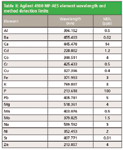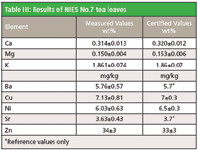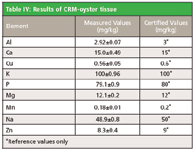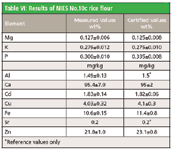Cost-Effective Analysis of Major, Minor, and Trace Elements in Foodstuffs Usint the 4100 MP-AES
Application Notebook
Whether the goal is food safety, ensuring quality, or establishing provenance, measuring the trace element content of foods and beverages that we all consume is of paramount importance. While some elements are essential for our well being at low concentrations, others like lead and chromium are highly toxic and more still are being linked to viral, neurological, and other diseases. Food scares related to contamination or poor quality not only constitute a health risk, they also undermine consumer confidence. This can lead to lost earnings through reduced sales and loss of credibility through adverse publicity.
Whether the goal is food safety, ensuring quality, or establishing provenance, measuring the trace element content of foods and beverages that we all consume is of paramount importance. While some elements are essential for our well being at low concentrations, others like lead and chromium are highly toxic and more still are being linked to viral, neurological, and other diseases. Food scares related to contamination or poor quality not only constitute a health risk, they also undermine consumer confidence. This can lead to lost earnings through reduced sales and loss of credibility through adverse publicity.
Atomic spectroscopy is well established for the analysis of metals in foods and the technique employed often depends on the requirements of the application in terms of elements of interest, expected concentrations, and number and type of samples. Other important procurement factors that influence instrument selection include purchase and operational budget for consumables, gases, power and labor, as well as service and maintenance costs.
With lab budgets coming under increasing pressure, Agilent has expanded its atomic spectroscopy portfolio to include the 4100 Microwave Plasma-Atomic Emission Spectrometer (MP-AES). MP-AES is a new analytical technique that uses a microwave-induced nitrogen plasma to provide elemental analysis, with significantly reduced running costs through the use of nitrogen as its plasma gas.
Experimental
This work describes the analysis of various certified and standard reference materials per the sample descriptions below:
- NIES CRM No.7 Tea Leaves: from National Institute of Environmental Studies (NIES), Japan
- NIES CRM No.10c Rice Flour: from National Institute of Environmental Studies (NIES), Japan
- CRM-Milk Powder: from High Purity Standards, USA
- CRM-Oyster Tissue: from High Purity Standards, USA
Sample Preparation
A simple acid digestion method was used to prepare the samples. Initially, 0.25 g of the tea leaves CRM, and 1 g of rice flour CRM were weighed into separate 250 mL beakers. This was then followed by the addition of 10 mL of HNO3 and each beaker was covered with a watch glass. The samples were heated on a hot plate until completely dissolved. After cooling to room temperature, each digest was transferred to a 100 mL volumetric flask and made up to the required volume by adding Milli-Q water.

Table I: Agilent 4100 MP-AES operating parameters
Pre-prepared sample solutions, CRM-Milk Powder and CRM-Oyster Tissue in 4% HNO3 were purchased from High Purity Standards, USA. Working standards and a blank were matrix-matched with the samples.

Table II: Agilent 4100 MP-AES element wavelength and method detection limits
Instrumentation
The innovative 4100 MP-AES with its proprietary microwave excitation assembly is a sequential atomic emission spectroscopic technique capable of fast, unattended multielement analysis at varying concentration levels using a nitrogen plasma. The unique microwave excitation assembly focuses and contains the microwave energy that is created via a concentrated axial magnetic field around the torch. This creates a robust toroidal plasma that allows the stable introduction of liquid samples. With a central channel temperature of ~5000 K, MP-AES is highly suited to spectroscopic analysis because it creates high intensity atomization emission lines. In addition to simplified spectra, nitrogen-MP-AES offers reduced operating costs and increased lab safety compared to flame AA, through the avoidance of costly and highly flammable gases such as acetylene. The analysis was carried out using an Agilent 4100 MP–AES equipped with a standard MP-AES torch, concentric nebulizer, and glass cyclonic spray chamber. Operating parameters are shown in Table I.

Table III: Results of NIES No.7 tea leaves
Results

Table IV: Results of CRM-oyster tissue
Method Detection Limits
The method detection limits were determined from the analysis of digested blank samples. The selected analytical wavelengths and method detection limits (3σ) are listed in Table II.
Analysis of Foodstuffs
Results of the analysis of major, minor, and trace extractable elements in different foodstuffs are listed in the tables below. The measured values (carried out in triplicate) are in good agreement with the certified values for all CRM and SRM samples.

Table V: Results of CRM-milk powder
Conclusions
MP-AES offers any food testing facilities dependent on acetylene-based instrumentation a real alternative in terms of sensitivity, multi-element capability and speed of analysis, while cutting operating costs and improving the safety of the lab environment through the use of non-flammable nitrogen. This study shows that following a quick and simple acid digestion sample preparation procedure (required for two of the four diverse food samples), all four certified and standard reference materials can be analyzed for trace and major element concentrations with good accuracy by MP-AES. The addition of the Agilent 4107 Nitrogen Generator is also possible in order to perform this analysis with significantly lower gas costs or for analysis in remote locations where sourcing of gases is costly or difficult.

Table VI: Results of NIES No.10c rice flour
Agilent Technologies
2315 Stevens Creek Blvd., Santa Clara, CA 95052
tel. (800) 227-9770; Fax (302) 633-8901
Website: www.agilent.com

A Seamless Trace Elemental Analysis Prescription for Quality Pharmaceuticals
March 31st 2025Quality assurance and quality control (QA/QC) are essential in pharmaceutical manufacturing to ensure compliance with standards like United States Pharmacopoeia <232> and ICH Q3D, as well as FDA regulations. Reliable and user-friendly testing solutions help QA/QC labs deliver precise trace elemental analyses while meeting throughput demands and data security requirements.